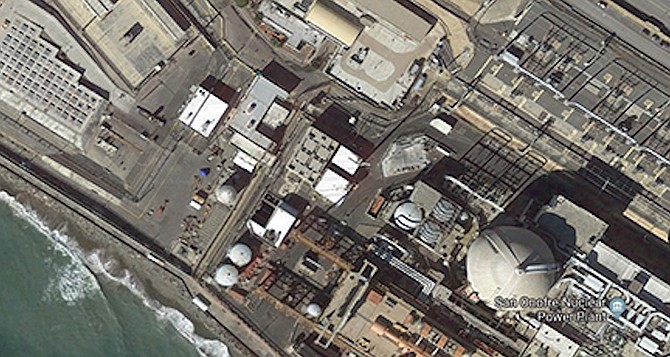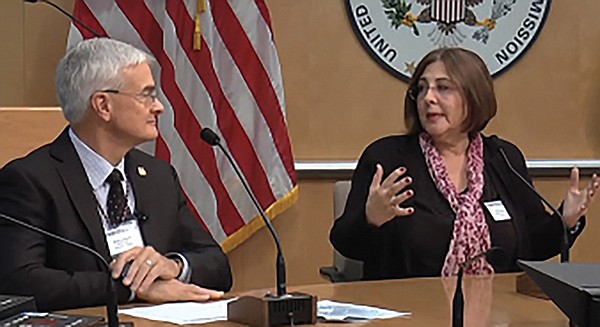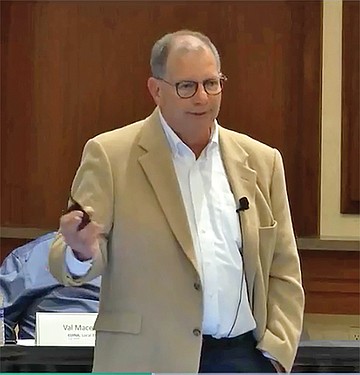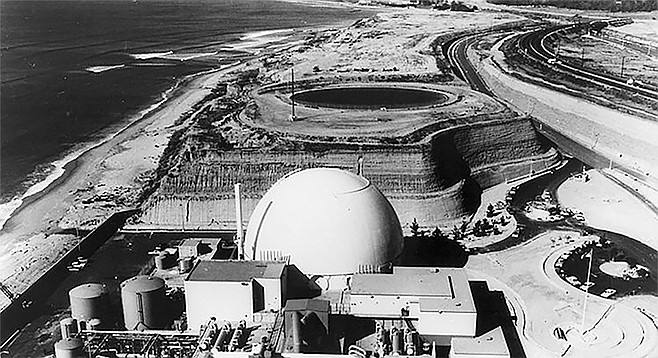 Facebook
Facebook
 X
X
 Instagram
Instagram
 TikTok
TikTok
 Youtube
Youtube

In March of this year, Southern California Edison, the major owner of the shuttered San Onofre nuclear plant, revealed that a shipment of canisters in which the company is burying nuclear waste near the ocean was defective. That same month, Tom Palmisano, Edison’s chief nuclear officer, admitted at a public meeting that while the company had sent back the shipment, “We have four canisters loaded [thus, filled with radioactive spent fuel] with this design where we have found a broken pin.” But the company is taking precautions to provide safety, he quickly claimed.

“Because we cannot inspect the cans — a way to do this has not been invented — we don’t know if the four cans that have been buried in their concrete silos have broken [pins],” says Charles Langley, executive director of Public Watchdogs, a group protesting Edison’s corner cutting. He sent me the video of Palmisano making the statement, and there is no doubt he admitted the burial.

Knowing Edison’s long reputation for falsification, people within 50 miles of the facility in North County near Orange County are understandably fearful. They believe the idea of burying radioactive spent nuclear fuel near the ocean is insane — and highly dangerous for current and future generations. For one thing, Edison’s inability to unload buried canisters is against Nuclear Regulatory Commission rules, notes Donna Gilmore of sanonofresafety.org, who also says the canisters are far too thin and will eventually leak radioactive material.

However, there is one institution that doesn’t seem to give a damn. It’s Edison. I combed through its most recent 10-Q quarterly report to the Securities and Exchange Commission. In a section listing risks of the San Onofre decommissioning, such as lawsuits and adverse regulatory decisions, there is no specific report on those thin canisters, the fact that some radioactive material is stored in potentially defective canisters, and the danger of burying highly dangerous spent nuclear fuel near the ocean. Apparently, the company doesn’t consider these material risks.
I asked Edison why it doesn’t seem to consider the ghastly potential at San Onofre as a material risk. I studied Wall Street analyst reports. It’s clear the analysts don’t consider these grim possibilities a risk to Edison stock. Indeed, a Morningstar analyst writes, “Edison has removed virtually all of its past overhangs [financial liabilities], such as its decision to close the San Onofre nuclear plant in 2013.” Now, I have been reading analysts’ reports for 54 years, and I know that in almost all cases the Wall Street folks get their information from the companies they report on.
So I asked Edison: Are you telling analysts that your San Onofre costs are pretty much over? And why don’t you list the thin canister dangers, as well as the decision to bury thin cans near the ocean, in your report to the securities commission?
Says the company, “Edison cannot speak for Wall Street or individual analysts.” Hmmm. That is a nonanswer. As to why the company does not list the dangerous thin canisters near the ocean as a risk factor, the company says, “Stainless steel canisters to store used nuclear fuel have been safely used in the [United States] for more than three decades.”
Nina Babiarz, cofounder of Public Watchdogs, says this sounds like Edison’s longstanding claim that there is a “low likelihood of any credible accident that could result in radiological conditions.” Those words “low likelihood” are not comforting.
Gilmore cites a statement by the Nuclear Waste Technical Review Board that spent nuclear fuel must be “retrievable, maintained, and monitored.” Edison’s thin-canister plan doesn’t meet those criteria. “Thin-wall canisters are vulnerable to short-term cracking and leaking, cannot be inspected inside or out, and cannot be maintained and monitored to prevent radioactive leaks,” she says on her website, sanonofresafety.org. The thin canisters in use now are only ½ to ⅝ inches thick. Gilmore prefers thick casks 10 to 19.75 inches thick, preferably stored in reinforced buildings, such as in Japan and Germany.
“The [Nuclear Regulatory Commission] solutions for adequate inspection and repair do not exist for canisters loaded with fuel,” she says on the website. Canisters can’t be unloaded back into the pool, although commission licenses require that they can be. In case of leakage, “The [commission] requires the ability to reverse the process, but there is no way to do it,” she says in an interview.
“In each canister is a Chernobyl disaster,” she says. And there are 8.5 million people within 50 miles of San Onofre, notes Langley. He and Gilmore agree that a San Onofre disaster could not only cause massive human death and maiming but cripple the California and United States economies.
The thick-wall casks are proven safe, says Gilmore. “Fukushima thick-wall casks survived the 2011 earthquake and tsunami,” she points out. But in the United States, the unholy alliance among the Nuclear Regulatory Commission, state regulatory commissions, and utilities permits usage of the unsafe thin canisters. “I was shocked to see the low standard of the nuke industry,” she says. “The only way they get away with it is being good at propaganda.”
San Diego attorney Mike Aguirre, who with his partner Maria Severson has kept the battle against the Edison regulators’ duplicity in the public eye, disagrees with Gilmore and Langley. “Safer canisters are not the solution. Moving them is the solution,” says Aguirre, who has no problem with thin canisters. “I want the canisters moved as far away from San Diego County as we can. There is no reason they can’t be transported. They are transported around Europe all the time.” He slams the public advocacy groups who abhor thin canisters near the ocean. “They use fear and ignorance to exploit people.” Their real mission is “fund-raising, fund-raising, fund-raising,” he complains.
Gilmore concedes that thick canisters in reinforced buildings couldn’t be located at San Onofre. There isn’t room. “There is no reason to take fuel across the U.S. and send it all to Texas, New Mexico, or Nevada,” she says. “Why should the Southwest get over 10,000 Chernobyl cans from the rest of the country?” she asks. In common with many others, she prefers a high spot at Camp Pendleton.
Meanwhile, more scary woes have come out. This month, a San Onofre worker, admitting his job might be in jeopardy, related at a public meeting how a canister packed with more than 30 spent fuel assemblies plunged almost 18 feet into a steel-lined concrete silo. He spoke out because his daughter lived nearby. How long can North County and Orange County residents stand living with such suspense?


In March of this year, Southern California Edison, the major owner of the shuttered San Onofre nuclear plant, revealed that a shipment of canisters in which the company is burying nuclear waste near the ocean was defective. That same month, Tom Palmisano, Edison’s chief nuclear officer, admitted at a public meeting that while the company had sent back the shipment, “We have four canisters loaded [thus, filled with radioactive spent fuel] with this design where we have found a broken pin.” But the company is taking precautions to provide safety, he quickly claimed.

“Because we cannot inspect the cans — a way to do this has not been invented — we don’t know if the four cans that have been buried in their concrete silos have broken [pins],” says Charles Langley, executive director of Public Watchdogs, a group protesting Edison’s corner cutting. He sent me the video of Palmisano making the statement, and there is no doubt he admitted the burial.

Knowing Edison’s long reputation for falsification, people within 50 miles of the facility in North County near Orange County are understandably fearful. They believe the idea of burying radioactive spent nuclear fuel near the ocean is insane — and highly dangerous for current and future generations. For one thing, Edison’s inability to unload buried canisters is against Nuclear Regulatory Commission rules, notes Donna Gilmore of sanonofresafety.org, who also says the canisters are far too thin and will eventually leak radioactive material.

However, there is one institution that doesn’t seem to give a damn. It’s Edison. I combed through its most recent 10-Q quarterly report to the Securities and Exchange Commission. In a section listing risks of the San Onofre decommissioning, such as lawsuits and adverse regulatory decisions, there is no specific report on those thin canisters, the fact that some radioactive material is stored in potentially defective canisters, and the danger of burying highly dangerous spent nuclear fuel near the ocean. Apparently, the company doesn’t consider these material risks.
I asked Edison why it doesn’t seem to consider the ghastly potential at San Onofre as a material risk. I studied Wall Street analyst reports. It’s clear the analysts don’t consider these grim possibilities a risk to Edison stock. Indeed, a Morningstar analyst writes, “Edison has removed virtually all of its past overhangs [financial liabilities], such as its decision to close the San Onofre nuclear plant in 2013.” Now, I have been reading analysts’ reports for 54 years, and I know that in almost all cases the Wall Street folks get their information from the companies they report on.
So I asked Edison: Are you telling analysts that your San Onofre costs are pretty much over? And why don’t you list the thin canister dangers, as well as the decision to bury thin cans near the ocean, in your report to the securities commission?
Says the company, “Edison cannot speak for Wall Street or individual analysts.” Hmmm. That is a nonanswer. As to why the company does not list the dangerous thin canisters near the ocean as a risk factor, the company says, “Stainless steel canisters to store used nuclear fuel have been safely used in the [United States] for more than three decades.”
Nina Babiarz, cofounder of Public Watchdogs, says this sounds like Edison’s longstanding claim that there is a “low likelihood of any credible accident that could result in radiological conditions.” Those words “low likelihood” are not comforting.
Gilmore cites a statement by the Nuclear Waste Technical Review Board that spent nuclear fuel must be “retrievable, maintained, and monitored.” Edison’s thin-canister plan doesn’t meet those criteria. “Thin-wall canisters are vulnerable to short-term cracking and leaking, cannot be inspected inside or out, and cannot be maintained and monitored to prevent radioactive leaks,” she says on her website, sanonofresafety.org. The thin canisters in use now are only ½ to ⅝ inches thick. Gilmore prefers thick casks 10 to 19.75 inches thick, preferably stored in reinforced buildings, such as in Japan and Germany.
“The [Nuclear Regulatory Commission] solutions for adequate inspection and repair do not exist for canisters loaded with fuel,” she says on the website. Canisters can’t be unloaded back into the pool, although commission licenses require that they can be. In case of leakage, “The [commission] requires the ability to reverse the process, but there is no way to do it,” she says in an interview.
“In each canister is a Chernobyl disaster,” she says. And there are 8.5 million people within 50 miles of San Onofre, notes Langley. He and Gilmore agree that a San Onofre disaster could not only cause massive human death and maiming but cripple the California and United States economies.
The thick-wall casks are proven safe, says Gilmore. “Fukushima thick-wall casks survived the 2011 earthquake and tsunami,” she points out. But in the United States, the unholy alliance among the Nuclear Regulatory Commission, state regulatory commissions, and utilities permits usage of the unsafe thin canisters. “I was shocked to see the low standard of the nuke industry,” she says. “The only way they get away with it is being good at propaganda.”
San Diego attorney Mike Aguirre, who with his partner Maria Severson has kept the battle against the Edison regulators’ duplicity in the public eye, disagrees with Gilmore and Langley. “Safer canisters are not the solution. Moving them is the solution,” says Aguirre, who has no problem with thin canisters. “I want the canisters moved as far away from San Diego County as we can. There is no reason they can’t be transported. They are transported around Europe all the time.” He slams the public advocacy groups who abhor thin canisters near the ocean. “They use fear and ignorance to exploit people.” Their real mission is “fund-raising, fund-raising, fund-raising,” he complains.
Gilmore concedes that thick canisters in reinforced buildings couldn’t be located at San Onofre. There isn’t room. “There is no reason to take fuel across the U.S. and send it all to Texas, New Mexico, or Nevada,” she says. “Why should the Southwest get over 10,000 Chernobyl cans from the rest of the country?” she asks. In common with many others, she prefers a high spot at Camp Pendleton.
Meanwhile, more scary woes have come out. This month, a San Onofre worker, admitting his job might be in jeopardy, related at a public meeting how a canister packed with more than 30 spent fuel assemblies plunged almost 18 feet into a steel-lined concrete silo. He spoke out because his daughter lived nearby. How long can North County and Orange County residents stand living with such suspense?
Comments